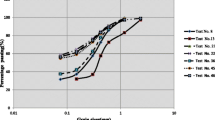Abstract
In upgrading the facilities of an International Airport in Southeastern Nigeria, the runway pavement is to be strengthened by increasing the asphalt concrete overlay thickness and introducing open-graded friction course beneath the overlay. As part of the runway upgrading, the hitherto grassed shoulder will be replaced with full flexible pavement. In evaluating the grassed shoulder a lightweight penetrometer LRS 10 was employed. The LRS 10 was deployed at an interval of 240 m on both shoulders. Most part of the shoulder length indicates penetration index (PI) values between 3.57 mm/blow and 8.8 mm/blow giving equivalent California Bearing Ratio (CBR) values in the range of 79–30% from the ground surface to about 0.40 m depth, and higher values of penetration index beyond the 0.40 m depth. There are few bands from the ground surface to 0.40 m depth in which the PI values are between 9.09 and 33.3 mm/blow; with equivalent CBR values of 29 –7%, respectively. The LRS 10 also indicate that the shoulders are characterized by soil with medium dense consistencies, with loosely dense soil occurring in those bands with high penetration index values. Soil classification of the shoulder indicates sandy clay, silty sand (SM) soils, except pockets of areas with high penetration index which are characterized with organic clays. Based on this investigation, an Earthworks program was developed for the proposed shoulder pavement construction. Correlation of the two methods of analysis employed to interpret the LRS 10 data leads to resolving one of the major limitations of the LRS 10 penetrometer.



Similar content being viewed by others
References
Allen JRL (1964) Nigerian continental margin. Mar Geol I:289–331
Allen JRL (1965) Late Quaternary Niger Delta and adjacent areas: sedimentary environments and lithofacies. AAPG Bull. 49(5):547–600
Ampadu SIK, Ayeh FF, Boadu JF (2018) Deriving SPT N-values from DCP test results: the case of foundation design in a tropical environment. Geotech Geol Eng. https://doi.org/10.1007/s1070
Annexe 14, Volume I. (2016) International Civil Aviation Organization, (ICAO). Aerodromes. Design and Operations. 7th Edition. pp 2–5, 3–12.Aerod
Baldi G, Bellotti R, Ghionna VN, Jamiolkowski M, Lo Presti DFC (1989) Modulus of sands from CPTs and DMTs. In: Proceedings of the 12th international conference on soil mechanics and foundation engineering. Rio de Janeiro. Balkema Publishers., Rotterdam, Vol 1, pp 165–170
Coonse J (1999) Estimating California bearing ratio of COHESIVE piedmont residual soil using the scala dynamic cone penetrometer, Master’s thesis, North Carolina State University, Raleigh, N.C
Done S, Samuel P (2006) Department for International Development (DFID). Measuring road pavement strength and designing low volume sealed roads using the dynamic cone penetrometer
Ese, Dag, Myre, Jostein, Nos, Per Magne, and Vaernes, Einar. (1994), the Use of Dynamic Cone Penetrometer (DCP) for road strengthening design in Norway, Proc., Int. Conf. on Bearing Capacity of Rd. and Airfield. pp3-22
Eslaamizaad S, Robertson PK (1996b) Cone penetration test to evaluate bearing capacity of foundation in sands. In: Proceedings of the CPT Guide—2015 Main References 130 49th Canadian Geotechnical Conference. St. John’s, Newfoundland. September, pp 429–438
Federal Highway Administration, FHWA NHI-05-037 (2006) Geotechnical Aspects of Pavements. pp 4–16, 4-44erat
Gabr MA, Hopkins K, Coonse J, Hearne T (2000) DCP criteria for performance evaluation of pavement layers. J Perform Constr Facil 14(4):141–148
Harison A (1987) Correlation between California bearing ratio and dynamic cone penetrometer strength measurement of soils. In: Proceedings of the institution of civil engineering, Part 2 pp 832–844
Idriss IM, Boulanger RW (2004) Semi-empirical procedures for evaluating liquefaction potential during earthquakes. In: Proceedings 11th, 11 international conference on soil dynamics and earthquake engineering. Berkeley, pp 32–56
Kulhawy FH, Mayne PW (1990) Manual on estimating soil properties for foundation design. Electric Power Research Institute, Palo Alto
Livneh M, Ishai I, Livneh NA (1994) Effect of vertical confinement on dynamic cone penetrometer strength values in pavement and subgrade evaluations, Transportation Research Record 1473, pp 1–8
DIN 4094, Part 2 (1980) Dynamic and Static Penetrometer
Robertson PK (2010) Soil behaviour type from the CPT: an update. In: 2nd international symposium on cone penetration testing, CPT’10, Huntington Beach, CA, USA www.cpt10.com
Robertson PK, Cabal (Robertson) KL (2015) Guide to cone penetration testing for geotechnical engineering. by gregg drilling and testing, Inc
Robertson PK, Campanella RG, Gillespie D, Rice A (1986) Seismic CPT to measure in situ shear wave velocity. J Geotech Eng Div ASCE 112(8):791–803
Salgado R, Yoon S (2003) Dynamic cone penetration test (DCPT) for subgrade assessment. FHWA/IN/JTRP-2002/30
Short KC, Stauble AJ (1967) Outline of the geology of Niger Delta. Bull AAPG 51:761–779
Transport and Road Research Laboratory (1990) A user’s manual for a program to analyse dynamic cone penetrometer data (Overseas Road Note 8). Crowthorne: Transport Research Laboratory, Berkshire, UK. Unpublished Project Report, UPR/IE/76/06.Project Record No. R7783. www.transport-links.org/ukdcp/docs/Manual/manual.html—(6/7/2013)
Author information
Authors and Affiliations
Corresponding author
Rights and permissions
About this article
Cite this article
Ilori, A.O. Assessing the unpaved shoulder of an airport runway for pavement construction using the lightweight penetrometer LRS 10. Innov. Infrastruct. Solut. 3, 77 (2018). https://doi.org/10.1007/s41062-018-0181-0
Received:
Accepted:
Published:
DOI: https://doi.org/10.1007/s41062-018-0181-0




